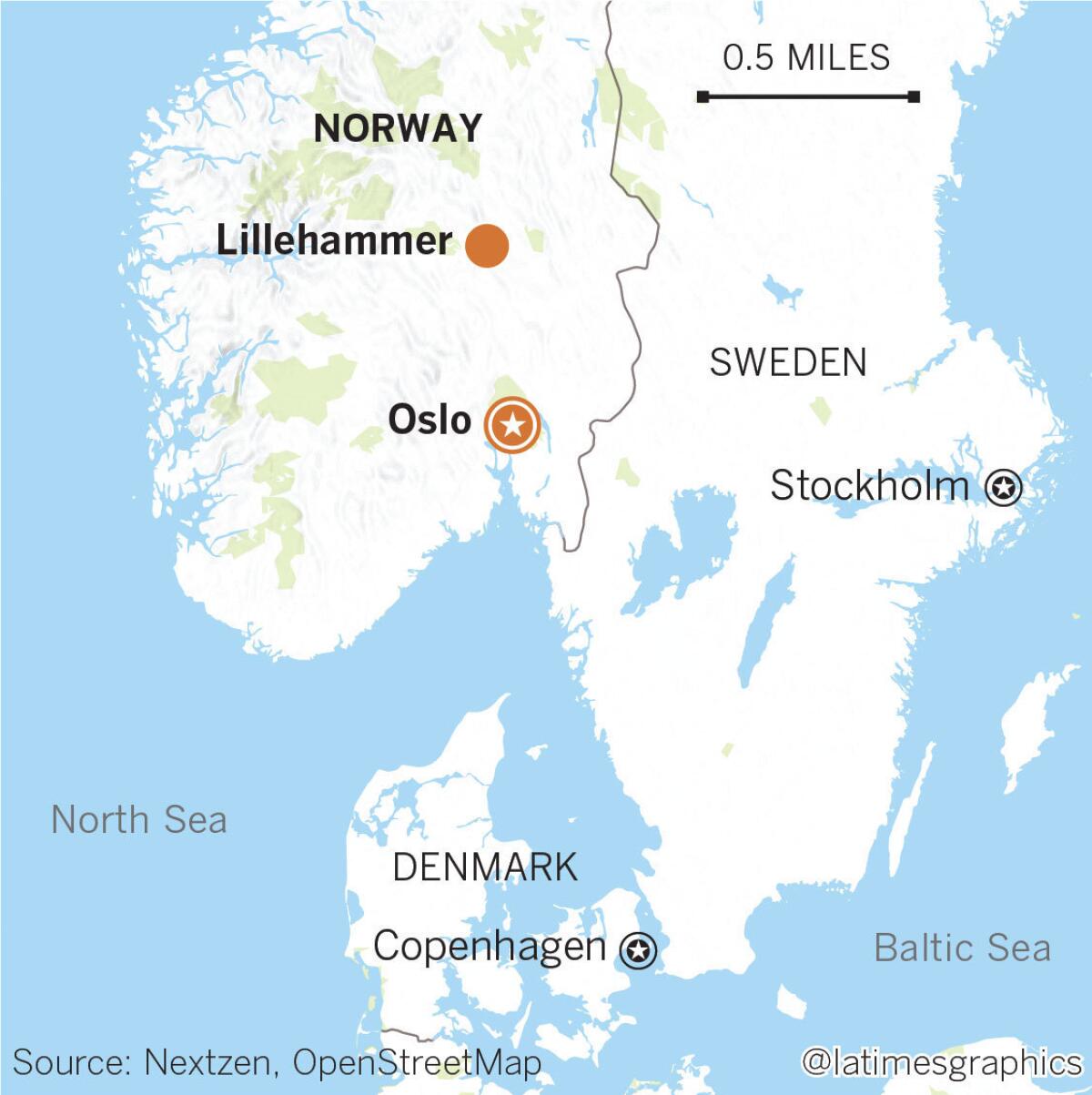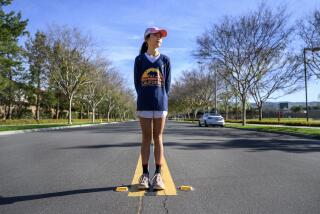At 70 mph, all was a blur, except the pain. Bobsledding in Norway? A blast. Really
The pain shot through my right shoulder, crunched by a force five times that of gravity. Within seconds, that same pain tore through my left side. Before I could ready myself for another impact, my right shoulder was assaulted again.
I was reeling from the sudden trauma, but the only thing I could do was think about how I had failed my instructions: Sit still and don’t move. That concept had seemed simple before my thrilling run down a former Olympic bobsled track.
I had come to Lillehammer to fulfill a boyhood dream, and I didn’t want to be the first person to cause our driver, Anders, to crash — the one thing he claimed had never happened to him.
“No sudden movements,” he had warned me minutes earlier when I was mentally intact and physically upright. “If you have to move, do it slowly. I don’t want to lose control.”
‘Cool Runnings’ fan
The spectacle of the Winter Olympics first captivated me when I was 6 years old, and one event in particular struck me. The bobsled was the most incredible thing I had ever seen.
I fell in love with the movie “Cool Runnings,” which told the story of four Jamaican sprinters who competed in the bobsled events at the 1988 Winter Olympics in Calgary, Canada. To me, it was settled: If these guys could become bobsledders with little training, well, one day so could I.

Two decades on, I was in Lillehammer. The modest Norwegian town hosted the Winter Olympics in 1994 and continues to host World Cup bobsled and luge events on one of the few competition-level tracks in the world.
The venue is open to the public, which means visitors can ride in an actual bobsled — something few other tracks allow. (The alternative, also available at Lillehammer, is the “bobraft,” which resembles an oversize foam cooler.)
My wife, Amanda, and I had made our way from London, paid about $115 each and prepared for our bobsled run. Anders and a colleague led us to a customized white van that took off up the mountain for the start of the course.
A white blur
When we arrived, there it was: a real four-man bobsled waiting for me — yes, me — at the entrance to the cream-colored chute.
Anders dragged it closer to the starting line before handing us black belts we were to use to protect our innards from the pressures of gravity. I nodded in understanding, before he prevented me from fastening it backward.
Then came the helmets, which went on correctly, and we were good to go. Because I was more flexible than Amanda, I was positioned in the rear of the sled. I was crushed.
Anders explained that I was to sit with my legs spread wide in a wishbone shape and my hands tucked under my knees to grip a pair of metal handles.
Amanda sat in front of me, and after those stern instructions not to move, Anders nudged us closer to the lip of the track. He donned his helmet and slid into his seat at the front of the sled.
We were off. The sled steadily approached the first left turn, then began picking up speed just after it. I tried to glance over Amanda’s shoulders when I could, but with the bobsled hitting speeds greater than 70 mph, everything was a white blur.
Then ... wham! After a gentle side-to-side jostling, we accelerated into turn 10 (of 16) — at which point the force of five Gs sent me hard to the right. I was pinned against the sled’s frame, which was about as tall as my collarbone.
I felt as though I had been hit by a baseball bat. But before I could react to the pain, we thrashed through another turn to the left, with the hull of the sled pinning me down on my left shoulder.
I had expected something akin to a roller-coaster ride, yet this was anything but. The force was tremendous and shifted continuously, leaving me unable to comprehend what was happening.
When the course leveled, I tried my best to pull myself upright and raise my head. I now understood the intense physical demands put on bobsled athletes and realized how any movement, however small, could cost a team the fraction of a second that often decides victory or defeat.
The sled creaked through a few more slight curves, but I hardly felt them, because of the shock of the two banked turns, the velocity we were traveling and the throbbing in my shoulders.
Just as I began to have regrets about making this journey, the sled suddenly threw me to the right once more, causing another crushing blow to my shoulder.
I noticed that Anders had pulled the brake when I felt a light spray on my face. It was now easier to sit upright as the sled rapidly decelerated.
All I could do was let out a dull, satisfied whoop when I saw the timing board at the end of the track. Anders had assumed our run might last 56 or 57 seconds. As we ground to a stop, we could see the board flashing a bright yellow 55.17.
He helped us out of our sled and out of our gear, then asked if the ride had lived up to expectations. I had no idea how to answer; I thought the run would last longer and that I would emerge less battered and shaken. But with my heart still pounding, it would have been hard to express anything other than thrill.
We said goodbye and thanked Anders for our experience, then retreated to the lodge midway down the track, where a surprise was waiting.
Although it wasn’t a gold medal, it was shiny — a pin certifying membership in the track’s 5G Club, given to those who have been down the track and experienced its delight.
I, No. 10393, was finally a bobsledder more than 20 years after being captivated by the sport.
If you go
THE BEST WAY TO LILLEHAMMER, NORWAY
From LAX, Norwegian offers nonstop service to Oslo, and Scandinavian, KLM, Lufthansa, Norwegian, British, Iceland and Air Canada offer connecting service (change of planes). Restricted round-trip airfare from $404, including taxes and fees.
Lillehammer can be reached by train from the Oslo airport station. Round-trip fares from $58, including taxes and fees.
TELEPHONES
To call the numbers below from the U.S., dial 011 (the international dialing code), 47 (country code for Norway) and the eight-digit local number.
WHERE TO STAY
Scandic Victoria Lillehammer, 84B Storgata, Lillehammer, Norway; 612-71-700. A downtown location in a modern property. Doubles from $102 a night, including breakfast and parking.
HI Lillehammer Stasjonen, 2 Jernbanetorget, Lillehammer, Norway; 612-60-024. A hostel above the train station. $35 per night for a shared room; $99 per person per night for a private room.
Clarion Collection Lillehammer, 108 Storgata, Lillehammer, Norway; 612-67-373. Bright yellow outside, modern inside. Doubles from $125 a night, including breakfast and dinner.
WHERE TO EAT
Heim Gastropub, 84 Storgata, Lillehammer; 611-00-082. Lively central meeting place with a wide-ranging menu. Ask to sample the aquavit. Most entrees $8-$21.
Nikkers, 18 Elvegata, Lillehammer; 612-47-430. A brewpub, bar and bistro with burgers and steaks — both beef and reindeer. Most entrees $20-$26.
Cafe Opus, 63 Storgata, Lillehammer; 612-67-844. Soups, salads, burgers and quesadillas, Entrees $10-$26.
TO LEARN MORE
Lillehammer Olympiaparken, 45 Nordsetervegen Lillehammer; 610-54-200
More to Read
Sign up for The Wild
We’ll help you find the best places to hike, bike and run, as well as the perfect silent spots for meditation and yoga.
You may occasionally receive promotional content from the Los Angeles Times.






